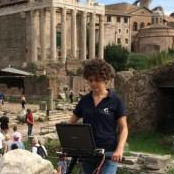Multiscale and Multitemporal High-Resolution Remote Sensing for Archaeology
A special issue of Remote Sensing (ISSN 2072-4292). This special issue belongs to the section "Remote Sensing Image Processing".
Deadline for manuscript submissions: closed (31 May 2022) | Viewed by 5222
Special Issue Editors
Interests: applied geophysics; ground-penetrating radar; electromagnetometry; magnetometry; electrical resistivity tomography
Special Issues, Collections and Topics in MDPI journals
Special Issue Information
Dear Colleagues,
The availability of high-resolution remote sensing techniques provides multiscale and multitemporal approaches to the study of ancient settlements and landscapes in order to reconstruct the development over the centuries. At present, this research requires the integration of different high-resolution remote sensing techniques: satellite (optical and radar data), aerial (photos, IR, and Lidar data) from airplanes and UAVs, as well as ground-based observations (integration of different geophysical techniques, field walking, DGPS topographical surveys). These investigations are based on a geoarchaeological approach, and are aimed at both historical reconstruction and the production of tools for preventive archaeology and the preservation of archaeological and monumental heritage.
The main topics will be:
- Satellite remote sensing for archaeology using optical and radar data: new perspectives, semiautomatic and automatic approaches for extracting cultural information, study of the interconnection between environmental changes and dynamics of human frequentation;
- Aerial archaeology: from historical and traditional air-photos to IR and Lidar data;
- Integration of ground remote sensing techniques (geophysical prospecting) and field walking and DGPS topographical surveys for the study of ancient settlements and landscapes;
- Integration of non-invasive methods for the preservation and protection of monumental heritage.
Dr. Lara De Giorgi
Dr. Giovanni Leucci
Guest Editors
Manuscript Submission Information
Manuscripts should be submitted online at www.mdpi.com by registering and logging in to this website. Once you are registered, click here to go to the submission form. Manuscripts can be submitted until the deadline. All submissions that pass pre-check are peer-reviewed. Accepted papers will be published continuously in the journal (as soon as accepted) and will be listed together on the special issue website. Research articles, review articles as well as short communications are invited. For planned papers, a title and short abstract (about 100 words) can be sent to the Editorial Office for announcement on this website.
Submitted manuscripts should not have been published previously, nor be under consideration for publication elsewhere (except conference proceedings papers). All manuscripts are thoroughly refereed through a single-blind peer-review process. A guide for authors and other relevant information for submission of manuscripts is available on the Instructions for Authors page. Remote Sensing is an international peer-reviewed open access semimonthly journal published by MDPI.
Please visit the Instructions for Authors page before submitting a manuscript. The Article Processing Charge (APC) for publication in this open access journal is 2700 CHF (Swiss Francs). Submitted papers should be well formatted and use good English. Authors may use MDPI's English editing service prior to publication or during author revisions.
Keywords
- satellite remote sensing
- aerial archaeology
- ground-penetrating radar
- magnetometry
- electrical resistivity tomography






